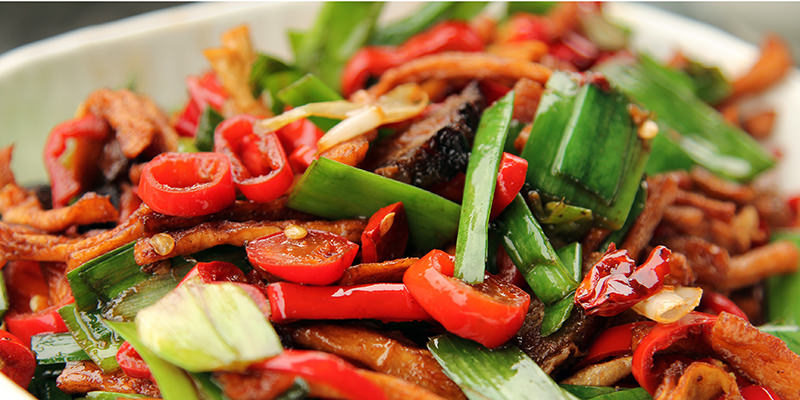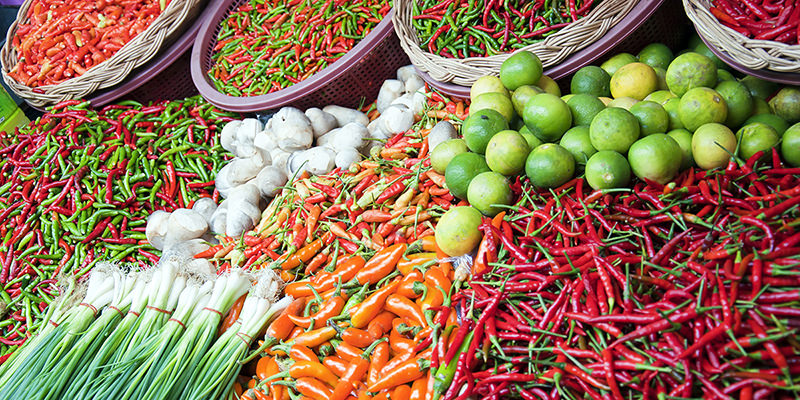‘Tis the season! Not to be jolly (though, yeah, feel free to get as jolly as you please). It’s summer, which, for many of us, means three months of shamelessly piling spice and chili-laced foods onto our plates, and rapidly thereafter into our mouths.
You don’t have to be a chili freak to appreciate the special, sizzling, slightly sadist thrill of eating something very hot in a very hot season. But there’s a logic to it. Consider the fact that you find heavily spiced, and often aggressively (like punch-in-the-palate) spicy cuisine around some of the world’s hottest countries. Probably not a coincidence, right? Before refrigeration technologies were available, spices (and salt) acted as preservatives in those warm countries. But the heat itself was also useful; it made you sweat, which cooled you down.
It might seem counterintuitive to beat the summer heat by knocking back a tablespoon of chili oil (mmmmm) under the noonday sun, but hot food makes you sweat—specifically, a kind of perspiration called “gustatory facial sweating.” Assuming you’re not in a sauna and that sweat’s able to evaporate, your body cools.
But enough sweat talk (we could go on an on about sweat). Even if there were no physiological rationale for eating spicy foods in the summertime, we’d still be doing it. The only problem we keep encountering, especially when we’re trying to pair with spicy Asian foods: that repetitive insistence on balancing out the heat of the cuisine with a slightly sweet wine.
Not that anybody’s recommending Sauternes to go with your Dan Dan Noodles. But spicy Asian dishes are often said to pair well with sweeter, typically white wines like a demi-sec Chenin Blanc, an off-dry Riesling, or crowd-favorite Moscato d’Asti. And that’s not entirely unfair: as long as the residual sugar levels are modest, and there’s a decent acidity cutting through it all, a slightly sweet wine can arguably make a great pairing for spicy Asian food. But there’s got to be other options, right? What if you absolutely hate sweet wine?

First off, you can’t go wrong with bubbles. Even dry bubbles. The acidity and effervescence of Champagne or Prosecco will actually help pronounce the heat present in the dish, so avoid this pairing if you’re looking to tame the heat. Because it’s steel-aged, Prosecco will be a little bit more brightly acidic, with delicate peachy citrus flavors, while Champagne tends to have a bit more breadiness to it, thanks to its time on the lees. (Remember those?)
Lighter, dry red wines like Pineau d’Aunis and fruity Gamays are also a good choice. Clearly, you never really want to go with anything either too high alcohol or too much oak; they’ll overpower and sort of dully neutralize the typically vibrant flavor profile of any spicy dish. You’ll also want to keep it lower tannin for the same reasons. Reach for a bottle of Nebbiolo over Cabernet, and don’t forget the power of dry rosé. With typically soft, but not sweet, fruitiness and lively acidity, dry rosé can make good friends with a huge variety of spicy Asian foods, from Thai curries to cold Korean noodles doused with gochujang, to delicate-skinned dumplings you’ve basically turned into a vehicle for the earthy, fruity burn of (real) chili oil.
As for beer—well, it’s a bit easier to pair spicy Asian food with beer. And not necessarily the Tsingtao or Kingfisher they have available in the restaurant. Although in truth, that’s the kind of style you’re looking for: a balance of malt and hops (nowhere near the IBU territory of modern IPA), and enough effervescence for palate-cleansing between monstrously hot bites. Lagers and pale ales are your best bet, although some dry fruity beers (like Dogfish Head’s Festina Peche or 21st Amendment Hell or High Watermelon).
Before you go forth and pair, we’d be remiss if we didn’t state the obvious. Spicy Asian dishes have a huge—a wondrously, generously huge—range of flavor profiles. What you’ll get in a dish of Chicken Vindaloo is very different from the salty/sweet/sour flavor profiles of Thai and Vietnamese cuisines. Accompanying ingredients like coriander in Indian cuisine or mint and basil in Thai can also help guide you in a new pairing direction. The common denominator is heat, but unless you’re eating something smothered in Ghost Pepper puree (and God help you), your palate will be picking up on other flavors.
Consider those factors when pairing (e.g., richer Indian spices can stand up to light to medium-bodied, low tannin dry reds). Just don’t feel like you’ve got to drink sweet.

